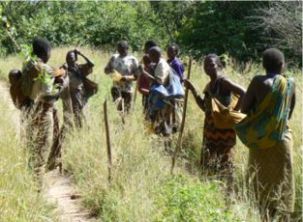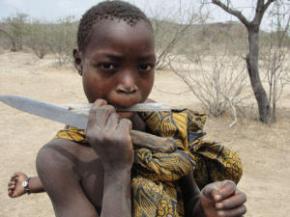Professor Maher sent me the paper linked below (thanks, Professor), which caused me a sinking of the heart when I realized that, if true, this research could completely sink my contention that women are fat because they need the stored energy to provide for pregnancy and lactation when times are lean. However, things are not nearly as bad as I feared!
Hunter-Gatherer Energetics and Human Obesity
Herman Pontzer, David A. Raichlen, Brian M. Wood, Audax Z. P. Mabulla, Susan B. Racette, Frank W. Marlowe
http://www.plosone.org/article/info%3Adoi%2F10.1371%2Fjournal.pone.0040503
Abstract
Western lifestyles differ markedly from those of our hunter-gatherer ancestors, and these differences in diet and activity level are often implicated in the global obesity pandemic. However, few physiological data for hunter-gatherer populations are available to test these models of obesity. In this study, we used the doubly-labeled water method to measure total daily energy expenditure (kCal/day) in Hadza hunter-gatherers to test whether foragers expend more energy each day than their Western counterparts. As expected, physical activity level, PAL, was greater among Hadza foragers than among Westerners. Nonetheless, average daily energy expenditure of traditional Hadza foragers was no different than that of Westerners after controlling for body size. The metabolic cost of walking (kcal kg−1 m−1) and resting (kcal kg−1 s−1) were also similar among Hadza and Western groups. The similarity in metabolic rates across a broad range of cultures challenges current models of obesity suggesting that Western lifestyles lead to decreased energy expenditure. We hypothesize that human daily energy expenditure may be an evolved physiological trait largely independent of cultural differences.
It certainly is a startling thesis statement: that all humans burn about the same amount of energy, give or take a standard deviation or two, regardless of whether we hunch over a hot keyboard all day, trudge under the African sun for many miles, or plant potatoes by hand on a high-altitude farm. This could certainly have put a stop to my slithering with my contention that humans are successful because they, especially the women, evolved a capacity to store fat. As I read the paper, however, I found a couple of questions burning at the back of my mind as I read, so I went back to the beginning and looked more closely. I don’t yet understand how doubly-labelled water is used to measure energy, but I can do arithmetic, so that’s what I did!
In Table 1, the researchers present their computations for Total Energy Expenditure per day, for Hadza hunter-gatherers, Westerners, and Bolivian farmers. They measured body mass, body fat percentage, and BMI, for each population.
It struck me – and the researchers noted this – that both the Hadza and the Bolivian farmers are considerably smaller than the Westerners. It seemed to me that energy expenditure per kilogram might be an interesting variable to consider rather than a blanket figure. So I sat down and worked out the TEE/kg of body mass for each group. Suddenly the picture changed, with a U curve appearing – see my table below. Note that the Hadza and Bolivian men use much the same amount of energy/kg BM, and considerably more than Western men, while Hadza women use less than Bolivians, and both use considerably more than Western women. If a Hadza woman is scaled up to the same weight as a Western woman, she would use 3217.8 kCal/day -870.8, or 2.42 standard deviations more, which is statistically significant. A Western woman scaled to Bolivian size would use 1517.55 kCal/day; a difference of 951.45 kCal LESS At 3.02 standard deviations, this is statistically significant.
| Hadza | Western | Farmers | ||||
| Women | Men | Women | Men | Women | Men | |
| Mass (BM) kg | 43.4 | 50.9 | 74.4 | 81.0 | 48.1 | 54.7 |
| BF % | 20.9 | 13.5 | 37.9 | 22.5 | 27.3 | 16 |
| Lean BM (LBM)
BM – BF |
34.3 | 45.9 | 46.2 | 62.8 | 34.9 | 45.9 |
| TEE/kCal/day | 1877 | 2649 | 2347 | 3053 | 2469 | 2855 |
| TEE/kgMass/day | 43.25 | 52.04 | 31.55 | 37.69 | 51.33 | 52.19 |
| TEE/kg LBM | 54.68 | 57.74 | 50.8 | 48.63 | 70.6 | 68.13 |
For the purposes of this quick-and-dirty analysis, I worked with average Body Mass, Body Fat, and Total Energy Expenditure.
Then I looked at TEE/kg lean body mass (I simply subtracted the body fat), and while the gap narrows between the Hadza and Westerners, the energy expenditure of the farmers goes way up, markedly widening the gap. However, I don’t think one should discard the fat, as while fat stores burn fewer calories per pound than muscle or brain or gut, even lean people have a fair number of pounds of fat! Further, the lean body mass includes bones, skin, gut, brain and muscle, each of which has varying energy needs. Hence, the energy needs of the whole organism, per kg body mass, seem to me to be a reasonable measure.
I found myself wondering how the energy needs were ascertained, and discovered that it was by calculation; the participants were asked to walk on a flat track, wearing ordinary clothes and sandals, at slow, medium, and fast paces set by a researcher walking alongside. The subject was wired up and energy usage measurements taken. The measurements taken were then multiplied by the average number of miles walked per day by Hadza men and women. The researchers admit that, as the Hadza walk over varied terrain at varied pace, Hadza energy output could be higher than the calculation.
Another thing that struck me was that there was no reference to burdened weight. A woman setting off on a foraging trip carries a fair load – she may have a baby in a sling or a toddler on her hip; if the latter, she may be pregnant. She’s probably carrying a container of water and some food; digging sticks and something with which to sharpen them (probably a panga), and a kaross or bag for the gathered food. On the way home, she’ll probably refill the water container, and she’ll be carrying many pounds of tubers, roots, and fruits, as well as the youngster, digging sticks, and panga. Atop this (literally), she probably collects firewood on her way home, bundling it onto her head.
Figure 1. Hadza women in the field. http://acoach4u.com/life_coach_gallery.htm Note children being carried, and bulging food collecting slings.
Figure 2. Hadza woman in harsher environment – note child on back, knotted sarong carrying food, panga. http://www.sciencedaily.com/releases/2012/01/120125132610.htm
Sarah Blaffer Hrdy, Mother Nature, p 198, describes a San woman’s foraging trip: in the last stages of pregnancy, she is carrying a 30lb 4 year old on her shoulders. Her kaross holds about 25lb of gathered food. Her personal belongings weigh another 5lb. She is carrying 60lb of weight outside her body plus the pregnancy weight. Anne Vincent, describing the use of tubers by Hadza women, photodocumented a woman loading her carrying sling with 20kg of tubers to carry home (1985: 138).
From my own experience, the physical changes of the last stages of pregnancy – the bulging belly, change in balance, and softening of the ligaments of the pelvic girdle, make walking more difficult and more tiring. When these factors are figured in, it would be surprising if the TEE for the day were not considerably higher than that calculated by Pontzer et al.
A man on his way to hunt is probably carrying a spear and thrower, or bow and arrows; he may also carry water and snacks. On his way home, he could be carrying a prey animal or several pounds of honey.
To me, it looks as if the energy needs of women in premodern societies are way higher than those of moderns, so much higher that stores of body fat are vital if the longterm reproductive success of the population through protracted periods of food shortages is to be assured.
Even if I am wrong in my basic assumptions here and Pontzer et al really have identified a stable energy output, and even if there really is no difference in energy output for pregnant and lactating women compared to women who are not pregnant or lactating, the role of maternal fat stores in transferring lipids to the infant (see The Fats of Life post) does not collapse and my hypothesis is not hopeless.
Hrdy, Sarah Blaffer. 1999. Mother Nature: a history of mothers, infants, and natural selection. Pantheon Books, Random House, Inc., New York, N.Y.
Vincent, Anne S. 1985. A preliminary report of tubers eaten by the Hadza of northern Tanzania. World Archaeology, 17(2):131-148.



